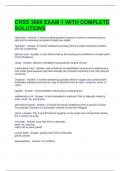CRSS 3060 EXAM 1 WITH COMPLETE
SOLUTIONS
Hydrolysis - Answer- a chemical decomposition reaction in which a chemical bond is
split and the elements contained in water are added
Hydration - Answer- A mineral weathering process wherein water molecules combine
with soil constituents
Igneous rock - Answer- a rock that formed by the cooling and solidification of liquid parts
of the lithosphere
Loess - Answer- deposit of windblown soil particles, largely silt size
metamorphic rock - Answer- rock formed by recrystallization of igneous or sedimentary
rock under great pressure and heat whereby the minerals contained in the rock become
reoriented
Oxidation - Answer- a mineral weathering process wherein oxygen ions combine with
multivalent elements such as iron, loss of electrons from an atom, molecule, anion, or
cation
regolith - Answer- unconsolidated material above solid bedrock
sedimentary rock - Answer- a rock composed of sediment, that is, deposits made by
water, wind, ice, and gravity
secondary mineral - Answer- a mineral formed by weathering from a primary mineral.
For example, Kaolinite is a secondary mineral formed from feldspar.
solum - Answer- The A and B horizons together or the single one of these that overlies
the C horizon at a site
fine earth - Answer- less than 2mm in diameter
sand, silt, and clay
major role in plant growth
course earth - Answer- greater than 2mm in diameter
gravel, stones
sand particles - Answer- 2 to 0.05mm
, silt particles - Answer- 0.05-0.002 mm. Too small to see without a microscope or to feel
individually. Feels smooth, but not sticky, even when wet. Has a floury feel.
clay particles - Answer- less than 0.002mm in diameter
soil texture - Answer- an expression of the relative amounts or percentages of sand, silt,
and clay. Permanent property.
soil structure - Answer- the arrangement of soil particles
porosity - Answer- the volume occupied in soil by pores
good number is 50%
red = - Answer- iron is oxidized, not hydrated
yellow = - Answer- indicated hydration and sometimes less oxidation
gray = - Answer- indicates chemical reduction caused by wetness and lack of oxygen
colloid particles - Answer- clay and organic particles that are so small they tend to
remain suspended in standing water
rhizosphere - Answer- the volume of soil, water, and air plus associated organisms
immediately around the root of a plant
name the six physiographic regions of Georgia - Answer- Valley and Ridge, Blue Ridge,
Piedmont, Sand Hills, Southern Coastal Plain, and Flatwoods
what is the oldest, most mature landscape of the Southeast? - Answer- Piedmont
hydrology equation - Answer- P = ET + Q + change in S
breakdown of hydrology equation - Answer- Precipitation, Evaporation and
Transpiration, water discharge, Storage of water in soil
soil - Answer- the layer(s) of generally loose mineral and/or organic material that are
affected by physical, chemical, and/or or biological processes at or near the planetary
surface, and usually hold liquids, gases and biota and support plant.
soil functions - Answer- Plant growth media, regulate water supply, recycle raw
materials, habitat for soil organisms, engineering medium
the four processes - Answer- additions, losses, transformations, translocations
additions - Answer- largely humus additions to the A horizon




